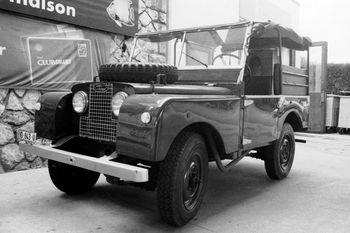.
Maurice Wilks: Difference between revisions
Red marquis (talk | contribs) mNo edit summary |
Red marquis (talk | contribs) mNo edit summary |
||
| Line 1: | Line 1: | ||
[[Image:Land-Rover-Rama27.jpg|right|thumb|[[Land Rover (Series/Defender)|Land Rover Series I]]]] | [[Image:Land-Rover-Rama27.jpg|right|350px|thumb|[[Land Rover (Series/Defender)|Land Rover Series I]]]] | ||
'''Maurice Cary Ferdinand Wilks''' (1904 - 1963) was the chief designer at the British car company [[Rover|Rover]] at the end of World War II, responsible for the development of the [[Land Rover (Series/Defender)|Land Rover]] utility vehicle. He discovered a need for the vehicle when using his own [[Willys MB|Willys Jeep]], (an old war jeep) on his farm in Newborough, Anglesey. Parts for this were available but could only be bought in bulk due to the army's overproduction of parts during the war. Wilks then decided, along with his brother [[Spencer Wilks]], the general manager at [[Rover]] during this time, that Rover should invest in an off road utility vehicle for farmers. Thus, the Land Rover was born. His first Land Rover was made in 1947, a hybrid built on a Jeep chassis using a Rover car engine and gearbox but retaining the Jeep transmission. This first prototype had a centrally mounted steering wheel so that the driver sat astride the gearbox rather like driving a tractor. The Rover company then authorised the production of 50 pre-production models (48 were actually built of which about half still survive) built entirely 'in-house', the steering now conventionally mounted for left or right hand drive. Actual production models began to roll off the lines, painted a light shade of green said to be from a surplus stock of aircraft cockpit paint, in mid 1948. This 80" wheelbase model is now known as the first of the 'Series 1' Land Rovers. | '''Maurice Cary Ferdinand Wilks''' (1904 - 1963) was the chief designer at the British car company [[Rover|Rover]] at the end of World War II, responsible for the development of the [[Land Rover (Series/Defender)|Land Rover]] utility vehicle. He discovered a need for the vehicle when using his own [[Willys MB|Willys Jeep]], (an old war jeep) on his farm in Newborough, Anglesey. Parts for this were available but could only be bought in bulk due to the army's overproduction of parts during the war. Wilks then decided, along with his brother [[Spencer Wilks]], the general manager at [[Rover]] during this time, that Rover should invest in an off road utility vehicle for farmers. Thus, the Land Rover was born. His first Land Rover was made in 1947, a hybrid built on a Jeep chassis using a Rover car engine and gearbox but retaining the Jeep transmission. This first prototype had a centrally mounted steering wheel so that the driver sat astride the gearbox rather like driving a tractor. The Rover company then authorised the production of 50 pre-production models (48 were actually built of which about half still survive) built entirely 'in-house', the steering now conventionally mounted for left or right hand drive. Actual production models began to roll off the lines, painted a light shade of green said to be from a surplus stock of aircraft cockpit paint, in mid 1948. This 80" wheelbase model is now known as the first of the 'Series 1' Land Rovers. | ||
Revision as of 06:53, 26 March 2008
Maurice Cary Ferdinand Wilks (1904 - 1963) was the chief designer at the British car company Rover at the end of World War II, responsible for the development of the Land Rover utility vehicle. He discovered a need for the vehicle when using his own Willys Jeep, (an old war jeep) on his farm in Newborough, Anglesey. Parts for this were available but could only be bought in bulk due to the army's overproduction of parts during the war. Wilks then decided, along with his brother Spencer Wilks, the general manager at Rover during this time, that Rover should invest in an off road utility vehicle for farmers. Thus, the Land Rover was born. His first Land Rover was made in 1947, a hybrid built on a Jeep chassis using a Rover car engine and gearbox but retaining the Jeep transmission. This first prototype had a centrally mounted steering wheel so that the driver sat astride the gearbox rather like driving a tractor. The Rover company then authorised the production of 50 pre-production models (48 were actually built of which about half still survive) built entirely 'in-house', the steering now conventionally mounted for left or right hand drive. Actual production models began to roll off the lines, painted a light shade of green said to be from a surplus stock of aircraft cockpit paint, in mid 1948. This 80" wheelbase model is now known as the first of the 'Series 1' Land Rovers.
His brother Spencer Bernau Wilks (1891 - 1971) was the General Manager of Rover, and a brother-in-law of John Black of the Standard Motor Company.

